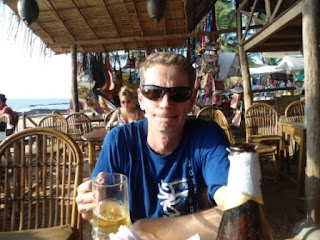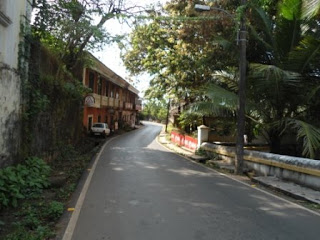This afternoon I was walking along one of Arambol’s back roads towards the beach when a huge cloud of dark smoke billowed through the trees. A foreigner behind me remarked “That’s a big fire!” Burning garbage is common in India but that has got to be a lot of garbage I thought. As I reached the main road the scene was a bit frantic. People were pushing motorbikes and scooters up the lane. A shopkeeper was tearing down the highly flammable weaved palm tree awning from above his storefront. A man was instructing a foreigner to pour water on her balcony. I looked down the road and could not see the beach just 30 metres away due to the thick smoke. An Indian yelled at a foreigner for taking a photo just as I had contemplated to do the same. There was a definite feeling of panic in the air.
I took a small alley and then a shortcut out to the beach and backtracked to see what was happening. A large crowd of tourists, both Indian and foreign, along with many locals were standing around looking on with curiosity, awe and shock at a recently erected beach restaurant, the Morningstar, that was engulfed in smoke. By this time the flames were pretty much out and the threat of it spreading to the permanent buildings behind it had dwindled. The place must have gone up like a matchbox with all of its dried palm weaved panels and dried palm fronds on the roof.
Arriving on the scene:

I snapped a few pics but then felt pretty useless. Of the few hundred people standing around watching, only about a dozen were doing anything about it. Sure, the main threat had gone but the sooner the remaining fire and hot spots were put out, the sooner the smoke would stop covering the nearby buildings that I’m sure suffered some smoke damage. I found a bucket under a sun bed, scooped some water out of a nearby pool from a small stream that empties onto the beach and poured it on the smouldering wood of the collapsed structure. I continued shuttling buckets of water back and forth for about 20 minutes along with others who would occasionally relieve me of my bucket and I would do the same with others. A few more people joined in including one of my favourite servers in Arambol, Johnny from the Om Star restaurant.
There was lots of smoke:

Smoky fire:
The restaurant shack is completely gone:

As the last flames were extinguished, guess who showed up? Of course, the firemen! Just in time guys. This incident made me realize how poor Arambol’s firefighting ability really is. Had the fire spread into the main building by the beach, who knows what would have happened? Later I was shown by the manager of 21 Coconuts Restaurant the three holes he got in his thatched roof from bits of flames jumping over. Luckily he had some guys on the roof to put these out.
The flames are pretty much out:

The fire truck finally arrives:
By this time, there wasn’t much for the firemen to extinguish (they're the ones with the yellow helmets):

The fire had decimated the restaurant in about 20 minutes. I read in the newspaper that the owner claims it cost him 6.75 lakhs, which is 675,000 rupees or about $13,500. The cause: faulty wiring hook-up to a refrigerator. The owner was planning his official season opening for the next day...d’oh!
I was surprised when that evening and the next morning I had six different Indian people, three of whom I didn’t know, remark to me that they saw me helping to put out the fire. I didn’t feel like I had done much but I guess it was more than most.
The next day I walked by the site around lunchtime and was amazed to see that the area had already been cleaned of all fire damage. In less than two weeks a new restaurant was constructed and the Morningstar Restaurant’s season officially opened...impressive.
The next day:

And back in business less than 2 weeks later:

















































